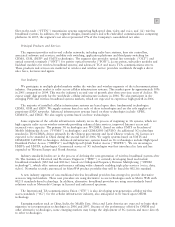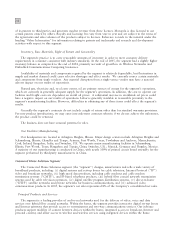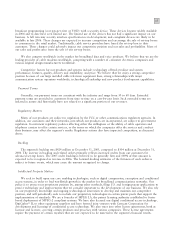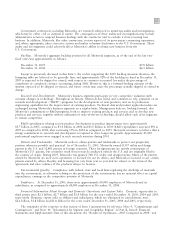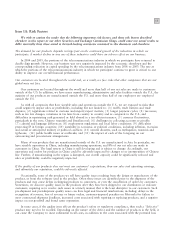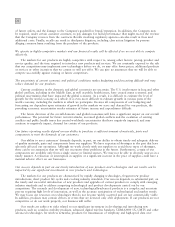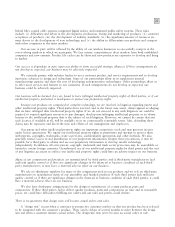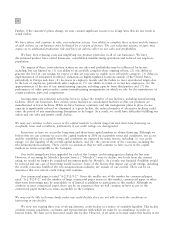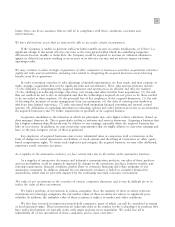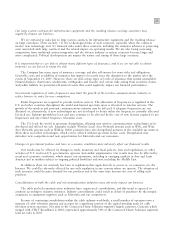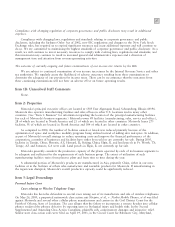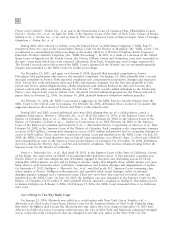Motorola 2005 Annual Report Download - page 26
Download and view the complete annual report
Please find page 26 of the 2005 Motorola annual report below. You can navigate through the pages in the report by either clicking on the pages listed below, or by using the keyword search tool below to find specific information within the annual report.
19
Item 1A: Risk Factors
We wish to caution the reader that the following important risk factors, and those risk factors described
elsewhere in this report or our other Securities and Exchange Commission filings, could cause our actual results to
differ materially from those stated in forward-looking statements contained in this document and elsewhere.
The demand for our products depends in large part on the continued growth of the industries in which we
participate. A market decline in any one of these industries could have an adverse effect on our business.
In 2004 and 2005, the portions of the telecommunications industry in which we participate have returned to
double digit growth. However, our business was very negatively impacted by the economic slowdown and the
corresponding reduction in capital spending by the telecommunications industry from 2001 to 2003. The rate at
which the portions of the telecommunications industry in which we participate continue to grow is critical to our
ability to improve our overall financial performance.
Our customers are located throughout the world and, as a result, we face risks that other companies that are not
global may not face.
Our customers are located throughout the world and more than half of our net sales are made to customers
outside of the U.S. In addition, we have many manufacturing, administrative and sales facilities outside the U.S., the
majority of our products are manufactured outside the U.S. and more than half of our employees are employed
outside the U.S.
As with all companies that have sizeable sales and operations outside the U.S., we are exposed to risks that
could negatively impact sales or profitability, including but not limited to: (1) tariffs, trade barriers and trade
disputes; (2) regulations related to customs and import/export matters; (3) longer payment cycles; (4) tax issues,
such as tax law changes, variations in tax laws from country to country and as compared to the U.S., and
difficulties in repatriating cash generated or held abroad in a tax-efficient manner; (5) currency fluctuations,
particularly in the euro, Chinese renminbi and Brazilian real; (6) challenges in collecting accounts receivable;
(7) cultural and language differences; (8) employment regulations and local labor conditions; (9) difficulties
protecting IP in foreign countries; (10) instability in economic or political conditions, including inflation, recession
and actual or anticipated military or political conflicts; (11) natural disasters, such as earthquakes, tsunamis and
typhoons; (12) public health issues or outbreaks; and (13) the impact of each of the foregoing on our
outsourcing and procurement arrangements.
Many of our products that are manufactured outside of the U.S. are manufactured in Asia. In particular, we
have sizeable operations in China, including manufacturing operations, and 8% of our net sales are made to
customers in China. The legal system in China is still developing and is subject to change. Accordingly, our
operations and orders for products in China could be adversely impacted by changes to or interpretation of Chinese
law. Further, if manufacturing in the region is disrupted, our overall capacity could be significantly reduced and
sales or profitability could be negatively impacted.
If the quality of our products does not meet our customers' expectations, then our sales and operating earnings,
and ultimately our reputation, could be adversely affected.
Occasionally, some of the products we sell have quality issues resulting from the design or manufacture of the
product, or from the software used in the product. Often these issues are identified prior to the shipment of the
products and may cause delays in shipping products to customers, or even the cancellation of orders by customers.
Sometimes, we discover quality issues in the products after they have been shipped to our distributors or end-user
customers, requiring us to resolve such issues in a timely manner that is the least disruptive to our customers. Such
pre-shipment and post-shipment quality issues can have legal and financial ramifications, including: delays in the
recognition of revenue, loss of revenue or future orders, customer-imposed penalties on Motorola for failure to
meet contractual shipment deadlines, increased costs associated with repairing or replacing products, and a negative
impact on our goodwill and brand name reputation.
In some cases, if the quality issue affects the product's safety or regulatory compliance, then such a ""defective''
product may need to be recalled. Depending on the nature of the defect and the number of products in the field, it
can cause the Company to incur substantial recall costs, in addition to the costs associated with the potential loss


